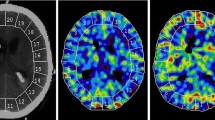Abstract
Purpose
This study was performed to investigate the role of injection methods and conditions under a fixed dose of radiographic contrast medium (CM) in respect to promoting blood–brain barrier (BBB) disruption.
Materials and methods
A total of 44 white rabbits (average body weight 2.7 ± 0.4 kg) were used, and their carotid injection was performed with nonionic CM. The variables assessed for the carotid injections included the following: iodine content (300 or 150 mg I/ml), liquid temperature (37° or 24°C), and the injection time duration (1 or 30 s). The rabbits were divided into five groups. To evaluate BBB disruption, pre- and post-contrast-enhanced magnetic resonance (MR) studies were performed.
Results
Abnormal enhancement of the brain parenchyma in MRI was noted in only one group, which consisted of high-iodine concentration CM injected at a low temperature over a short injection interval. Statistically significant increased values for the percentage of relative enhancement (RE%) were demonstrated (P < 0.05) in comparison with the saline-injected control group.
Conclusion
This result suggests variables that may need to be carefully considered to prevent BBB injury induced by nonionic CM for cerebral angiography, especially in the setting of a neurointerventional procedure.
Similar content being viewed by others
References
J Velden P Milz F Winkler K Seelos GF Hamann (2003) ArticleTitleNonionic contrast neurotoxicity after coronary angiography mimicking subarachnoid hemorrhage Eur Neurol 49 249–51 Occurrence Handle12736546 Occurrence Handle10.1159/000070198
C Sticherling J Berkfield W Auch-Schwelk H Lanfermann (1998) ArticleTitleTransient bilateral cortical blindness after coronary angiography Lancet 351 570 Occurrence Handle9492782 Occurrence Handle1:STN:280:DyaK1c7ltlOhuw%3D%3D Occurrence Handle10.1016/S0140-6736(05)78557-3
H-J Mentzel A Malich C Fitzek JR Reichenbach W Kaiser (2003) ArticleTitleCortical blindness after contrast-enhanced CT: complication in a patient with diabetes insipidus AJNR Am J Neuroradiol 24 1114–6 Occurrence Handle12812935
RL Waldron Suffix2nd RB Breidenbaugh EW Dempsey (1974) ArticleTitleEffect of angiographic contrast media the cellular level in the brain: hypertonic vs. chemical action AJR Am J Roentogenol 122 469–76
MR Sage (1985) ArticleTitleEffects of intracarotid ioxaglate on the normal blood-brain barrier: a comparison of the two animal models Neuroradiology 27 342 Occurrence Handle4047391 Occurrence Handle10.1007/BF00339569
F Earnest Suffix4th G Forbes BA Sandok DG Peipgras RJ Faust DM Ilstrip et al. (1984) ArticleTitleComplications of cerebral angiography: prospective assessment of risk AJR Am J Roentgenol 142 247–53 Occurrence Handle6198889
JF De Wispelaere JP Trigaux B Van Beers C Gilliard (1992) ArticleTitleCortical and CSF hyperdensity after iodinated contrast medium overdose: CT findings J Comput Assist Tomogr 16 998–1003 Occurrence Handle1430459 Occurrence Handle1:STN:280:DyaK3s%2FlsFOnsg%3D%3D
K Hayakawa K Yamashita M Mitsumori (1990) ArticleTitleBlood-brain barrier injury following intracarotid injection of radiographic contrast media Acta Radiol 31 203–8 Occurrence Handle2372465 Occurrence Handle1:STN:280:DyaK3czitFOnsQ%3D%3D Occurrence Handle10.3109/02841859009177489
H Okazaki K Tanaka T Shishido (1989) ArticleTitleCase report: disruption of the blood-brain barrier caused by nonionic contrast medium used for abdominal angiography: CT demonstration J Comput Assist Tomogr 13 893–5 Occurrence Handle2550530 Occurrence Handle1:STN:280:DyaL1MzotV2qtQ%3D%3D
Y Numaguchi MS Fleming K Hasuo FA Puyau CMJ Nice (1984) ArticleTitleBlood-brain barrier disruption due to cerebral arteriography: CT findings J Comput Assist Tomogr 8 936–9 Occurrence Handle6432864 Occurrence Handle1:STN:280:DyaL2c3ptVWmug%3D%3D
W Dillon M Brant-Zawadzki RG Sherry (1984) ArticleTitleTransient computed tomographic abnormalities after focal seizures AJNR Am J Neuroradiol 5 107–9 Occurrence Handle6421118 Occurrence Handle1:STN:280:DyaL2c7isVygsg%3D%3D
Y Uchiyama T Abe M Hirohata N Tanaka K Kojima H Nishimura et al. (2004) ArticleTitleBlood-brain barrier disruption of nonionic iodinated contrast medium following coil embolization of a ruptured intracerebral aneurysm AJNR Am J Neuroradiol 25 1783–6
U Speck (Eds) (1995) X-ray contrast media: overview, use, and pharmaceutical aspects. 2nd edition. Translated by K. Yamaguchi K Springer Tokyo
L Junck WH Marshall (1982) ArticleTitleFatal brain edema after contrast-agent overdose AJNR Am J Neuroradiol 138 887–98
VM Runge AC Price CJ Wehr JB Atkinson MF Teedle (1985) ArticleTitleContrast enhanced MRI: evaluation of a canine model of osmotic blood-brain barrier disruption Invest Radiol 20 830 Occurrence Handle4077437 Occurrence Handle1:STN:280:DyaL28%2FosV2isQ%3D%3D
RA Simon M Schatz DD Stevenson (1979) ArticleTitleRadiographic contrast media infusions: measurement of histamine, complement, and fibrin split products and correlation with clinical parameters J Allergy Clin Immunol 63 281–8 Occurrence Handle85650 Occurrence Handle1:STN:280:DyaE1M7ltF2nug%3D%3D Occurrence Handle10.1016/0091-6749(79)90114-3
SI Rapoport HK Thomson JM Bidinger (1974) ArticleTitleEqui-osmolal opening of the blood-brain barrier in the rabbit by different contrast media Acta Radiol Diagn (Stockh) 15 21–32 Occurrence Handle1:CAS:528:DyaE2cXkslaltLg%3D
BB Johansson (1989) Hypertension and the blood-brain barrier EA Neuwelt (Eds) Implication of the blood-brain barrier and its manipulation. Vol 2 Plenum New York 389–410
FB Byrom (1954) ArticleTitleThe pathogenesis of hypertensive encephalopathy and its relation to the malignant phase of hypertension: experimental evidence from the hypertensive rat Lancet 2 201–11 Occurrence Handle10.1016/S0140-6736(54)91821-8
M Manfredi A Beltramello LG Bongiovanni A Polo L Pistoia N Rizzuto (1997) ArticleTitleEclamptic encephalopathy: imaging and pathogenetic considerations Acta Neurol Scand 96 277–82 Occurrence Handle9404996 Occurrence Handle1:STN:280:DyaK1c%2FmslGjsg%3D%3D Occurrence Handle10.1111/j.1600-0404.1997.tb00284.x
MR Sage J Wilcox CA Evill GT Benness (1983) ArticleTitleComparison of the blood-brain barrier disruption by intracarotid iopamidol and methylglucamine iothalamate AJNR Am J Neuroradiol 4 893–5 Occurrence Handle6410875 Occurrence Handle1:STN:280:DyaL3s3nvFKrug%3D%3D
TW Morris MA Kern RW Katzberg (1982) ArticleTitleThe effects of media viscosity on hemodynamics in selective arteriography Invest Radiol 17 70–6 Occurrence Handle7076438 Occurrence Handle1:STN:280:DyaL387ovFakuw%3D%3D
J Wilcox MR Sage (1984) ArticleTitleIs viscosity important in the production of blood-brain barrier disruption by intracarotid contrast media? Neuroradiology 26 511–2 Occurrence Handle6504320 Occurrence Handle1:STN:280:DyaL2M%2FmtF2hug%3D%3D Occurrence Handle10.1007/BF00342690
AJ Wilson J Wicox CA Evill MR Sage (1989) ArticleTitleThe effect of contrast medium viscosity on the blood-brain barrier after intracarotid injection in the rabbit AJNR Am J Neuroradiol 10 129–33 Occurrence Handle2536998 Occurrence Handle1:STN:280:DyaL1M7jt1aguw%3D%3D
D D’Avella R Cicciarello F Albiero G Piscitelli MG Fiori M Mesiti P Princi S d’Aquino (1989) ArticleTitleEffect of intracarotid injection of iopamidol on local cerebral glucose utilization in rat brain AJNR Am J Neuroradiol 10 797–801 Occurrence Handle2505507 Occurrence Handle1:STN:280:BiaA2s7jtFE%3D
Author information
Authors and Affiliations
Corresponding author
About this article
Cite this article
Uchiyama, Y., Abe, T., Tanaka, N. et al. Factors contributing to blood–brain barrier disruption following intracarotid injection of nonionic iodinated contrast medium for cerebral angiography: experimental study in rabbits. Radiat Med 24, 321–326 (2006). https://doi.org/10.1007/s11604-006-0030-5
Received:
Accepted:
Issue Date:
DOI: https://doi.org/10.1007/s11604-006-0030-5




